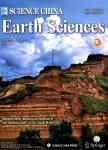Carbon and hydrogen isotopic characteristics of natural gases from the Luliang and Baoshan basins in Yunnan Province, China
Carbon and hydrogen isotopic characteristics of natural gases from the Luliang and Baoshan basins in Yunnan Province, China作者机构:Lanzhou Center of Oil & Gas Resources Institute of Geology and Geophsics Chinese Academy of Sciences Lanzhou China Research Institute of Petroleum Exploration and Production SINOPEC Beijing China South Branch of Petroleum Exploration and Production Company SINOPEC Kuming China
出 版 物:《Science China Earth Sciences》 (中国科学(地球科学英文版))
年 卷 期:2006年第49卷第9期
页 面:938-946页
核心收录:
学科分类:070902[理学-地球化学] 0709[理学-地质学] 07[理学] 0708[理学-地球物理学] 0704[理学-天文学]
基 金:This work was supported by the National Natural Science Foundation of China(Grant No.40373001) the National'973'Project of Natural Gas(Grant No.2001CB209102)
主 题:bacterial gas, carbon and hydrogen isotope, CO2 reduction, acetate fermentation.
摘 要:The Luliang and Baoshan basins of Yunnan Province are two small-sized continental oil/gas-bearing sedimentary basins, which were developed at the bases of the Carboniferous and Devonian systems during the Late Tertiary, covering an area of 325 km2 and 254 km2, respectively. Since the 1990s, there have been discovered small-sized natural gas pools in these two basins. The natural gases are composed mainly of hydrocarbon gases, with nonhydrocarbons accounting for less than 2%. Of the hydrocarbon gases, methane accounts for more than 99%, and the components above C2 account for less than 0.2%. On the basis of previous studies of geological background, the composition of natural gases and their carbon isotopic composition, it has been defined that these two gas pools are of bacterial origin. In this work we have comprehensively measured the carbon and hydrogen isotopic composition of natural gases from these two basins and have gone into the details of the mechanism of gas generation. The δ 13C1 values of natural gases from the Luliang Basin are within the range of –72.1‰―–73.3‰, and the δ DCH4 values, –242‰―–234‰, indicating that the bacterial gas generation is dominated by the way of CO2 reduction. It has been evidenced that under continental-facies fresh water conditions there did occur the CO2 reduction as a process of bacterial gas generation. The δ 13C1 values of natural gases from the Baoshan Basin are within the range of –62.5‰―–63.5‰, and the δ DCH4 values, –252‰―–260‰. These isotopic characteristics are fallen into transitional phase of acetate fermentation and CO2 reduction as defined by Whiticar et al. (1986). An important discovery in the Luliang Basin is the carbon isotopic composition of ethane of purely biogenetic origin, i.e., its δ 13C2 values are within the range of –61.2‰―–66.0‰. These carbon iso- topic values have been reported for the first time in China. As compared to the δ 13C2 values of less than –55‰ for the two cases encountered previously in



